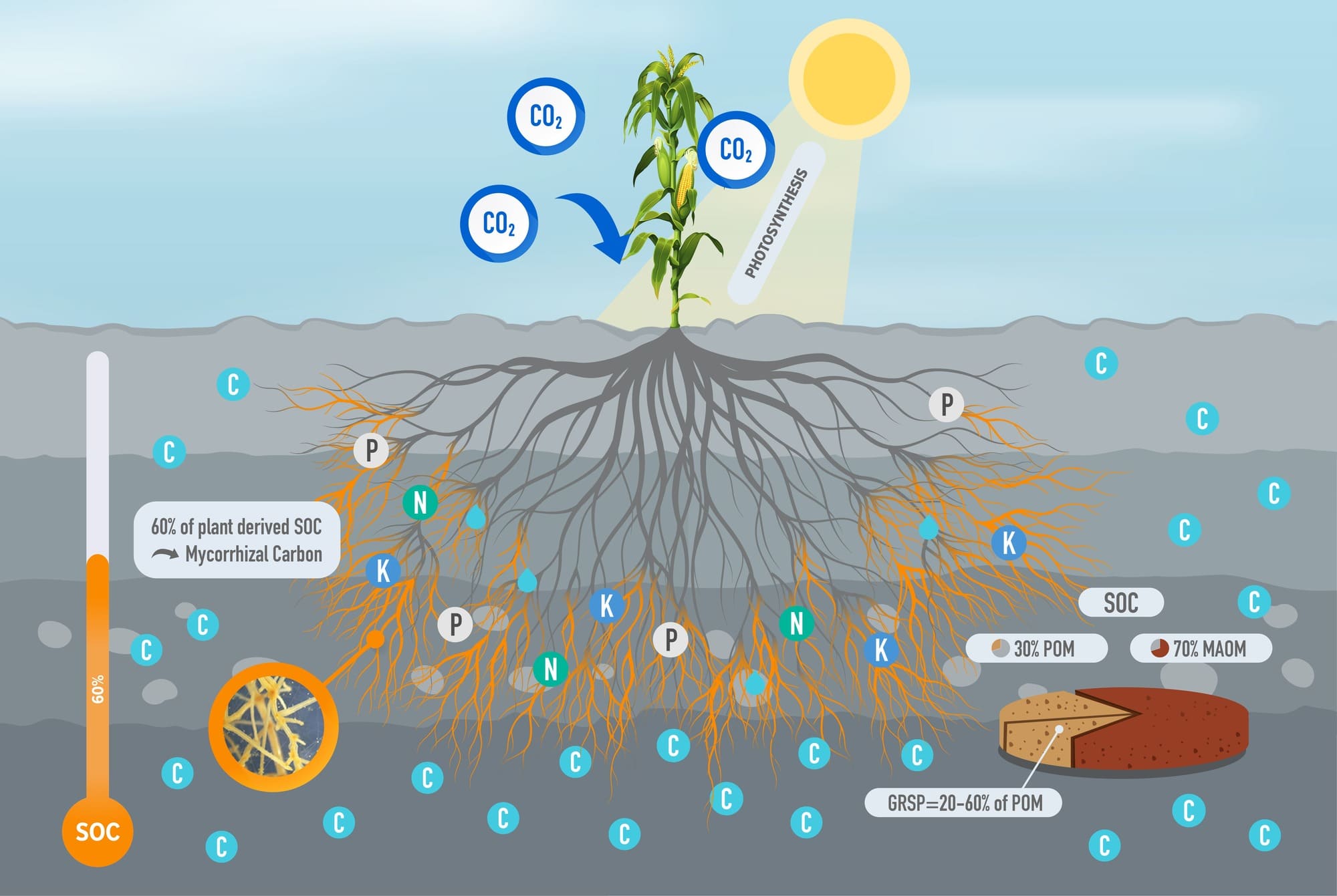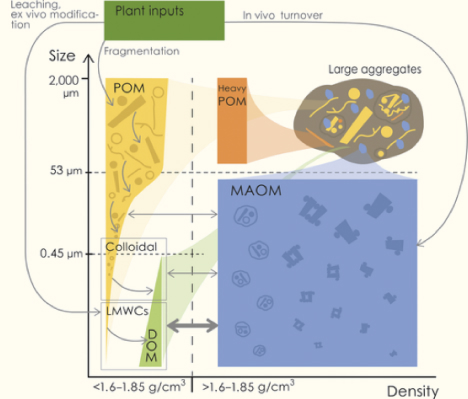Mycorrhizal Carbon™
The Carbon Trail from Photosynthesis to Permanence
Mycorrhizae are the main
pathway for carbon into the soil.
Estimated to sequester up to 13.12 Gt of CO2eq annually, the rise of fungal-plant relationships over 475 million years ago corresponded “with a 90% reduction in atmospheric CO2 levels”. However, modern agriculture has destroyed much of the microbial soil matrix, eliminating mycorrhizae, depleting the soils of carbon, and releasing 785 GtCO2eq into the atmosphere in the process. Mycorrhizal inoculation, the most effective method of restoring microbial communities into agricultural ecosystems, promises to permanently draw down that carbon back where it belongs – in our soil.

Mycorrhizal symbiosis is based on an architecture of mutually beneficial exchange: the fungi provide precious nutrients to plants, and the plants return the favor with photosynthesized sugars (carbohydrates), which become carbon.
While plants photosynthesize carbon from the atmosphere, mycorrhizae permanently sequester it in the soil.
Here’s how it works:
- Mycorrhizal plants allocate up to 20% of their photosynthate, or Net Primary Production (NPP), to mycorrhizae. This means that up to 20% of photosynthesized carbon becomes mycorrhizal carbon.
- This massive influx of carbon into the soil is greater than the typical efflux of carbon from agricultural soils due to soil respiration – generating a positive net flux of carbon into the soil. Mycorrhizae-rich soils therefore absorb more carbon than they release.
- Mycorrhizae are associated with the presence of Glomalin-Related Soil Proteins (GRSP) – a family of recalcitrant glycoproteins that are comprised of approximately 47% carbon and which make up 6-18% of the world’s Soil Organic Carbon (SOC). GRSP have been shown to be stable, even in conventional agricultural soils, for decades.
- In addition to retaining carbon, GRSP act as a sticky soil adhesive, aggregating soil particles, and creating tilth. This enhanced soil particle aggregation promotes the formation of Mineral-Associated Organic Matter (MAOM), a stable carbon sink that makes up approximately two-thirds of the world’s SOC and is estimated to last up to 10,000 years.
The 2nd largest carbon sink in the world is in the soil under our feet
Carbon is at a surplus in the air and a deficit in the soil.
Mycorrhizae are rebalancing that relationship.
Pathways to Carbon Permanence
Up to 60% of all plant-derived soil organic carbon (SOC) is attributed to mycorrhizae. A portion of the SOC is then sequestered permanently within recalcitrant glycoproteins that remain stable – even after decades of tillage. As a vital component of the carbon sequestration cycle, mycorrhizae facilitate carbon permanence via three main modes of action: carbon net influx, glomalin-related soil protein (GRSP), and mineral-associated organic matter (MAOM).
Net Positive Carbon Influx:
As the main pathway of carbon into the soil, mycorrhizae are responsible for up to 60% of all plant-derived organic carbon entering the soil. Applying mycorrhizal inoculants results in a net influx of 1-4 tons of CO2 equivalent per acre per year.
Glomalin-Related Soil Protein (GRSP)
GRSP – the most persistent form of Particulate Organic Matter – is present where mycorrhizae are abundant and is recalcitrant and stable from 7 to 42 years. 6 to 18% of total global SOC is estimated to be stored in GRSP. Chrono-sequencing studies have found that GRSP reaches a steady state, even under decades of continuous conventional agricultural activity. Assuming successful mycorrhizal inoculation and a GRSP pool size of 1.8 t C/acre, as well as an exponential decay rate of k=0.103, we calculate an influx of 0.6798 tCO2eq/acre.

Mineral-Associated Organic Material (MAOM)
MAOM formation is enhanced by mycorrhizal activity, which exudes adhesive matter and aggregates soil particles. MAOM can contain up to 80% of Total Organic Carbon in healthy soil and persists from 100 to up to 10,000 years. In carbon-depleted soil – including conventional cropland – it is estimated that 10-50% of mycorrhizal carbon may be converted to MAOM within one year. Thus, mycorrhizae can add 0.1-2 tCO2eq/(acre*yr) of MAOM to carbon-depleted agricultural soil, where it resides for hundreds of years.

The Bottom Line: Significant Mycorrhizal Carbon Sequestration Potential
300M acres of mycorrhizal corn can potentially sequester 1 gigaton of CO2 equivalent.

